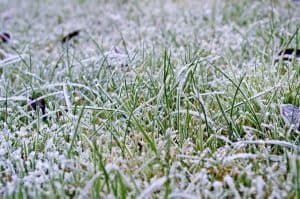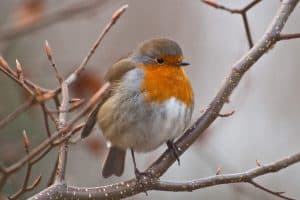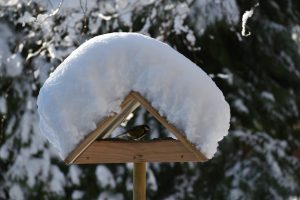Jump to:
December is here in force, and with it is every avid gardener’s least favourite season. That’s right, we’re talking about winter.
Not only is it difficult to get outside during this season, but the winter months can also be a dangerous time for your garden. Frost, snow, freezing cold winter temperatures – it can be the stuff of nightmares if you’re not prepared or don’t know what to do.
If that sounds familiar, then don’t worry – we’ve got you covered with this guide on protecting and preparing your garden for winter. We’ll be showing you which things you need to do to ensure your garden survives the cold weather, and prepare it so that it’s ready for the brilliant bloom of spring.
Alternatively, if you need help with getting your shed “winterized”, then check out our winter-shed guide here!
But today we’re talking about gardens, So get your wellies, coat, and gardening gloves ready. Let’s get those gardens protected!

Keep Your Grass Happy
There’s nothing more important in maintaining the appearance of your garden than keeping your lawn looking stellar. Winter can be a difficult time for grass, especially when the frosts hit!
Fortunately, there are only a couple of things you need to bear in mind to ensure your grass comes out of the winter season in good shape – let’s check them out.
Clear anything on top
Sunlight is hard to come by in winter, and especially hard for grass if their sight of the sun is blocked by leaves or other debris. Without sunlight, the grass cannot photosynthesise and stay alive. A lack of sunlight also makes it more difficult for frost to melt away from grass when it’s especially cold.
That’s why one of the best things you can do for your lawn is to keep it as clear as possible.
Rake or brush away as much debris, although try to be as gentle as possible while you’re doing it. Clearing the lawn will allow what sunlight there is to reach the grass and keep it content. You don’t have to clear away every single leaf as soon as it lands, but don’t let a large ground cover accumulate over a few weeks.
Keep off the grass!

If you’ve been anywhere where the grass is immaculately cut and tended, you might have seen those signs telling you very boldly to “keep off the grass”. If you’ve ever seen one, I’m afraid it’s now time to take that advice and stay off your own lawn!
Don’t worry, we’re not trying to police how you use your garden. We’re just warning you that walking on your grass during winter can actually do it harm.
The cold weather and tough ground of winter makes the grass blades more fragile than usual. Damage that they might be able to easily withstand in warmer months could actually do real harm to the grass – this even includes walking on it.
Now you don’t need to worry about walking over it now and again – but avoid having large numbers of people on the turf for extended periods of time. Your grass will thank you for it and show you the benefits come springtime!
Prune Your Plants

With plants being able to grow very little – or hardly at all – during winter, it’s the perfect time to get pruning.
For the uninitiated, pruning is the process of cutting away branches from a plant, tree, or bush. You’re looking to remove unwanted branches and dead growth.
There are a bunch of benefits to pruning, including…
- Promoting new, stronger, and healthier growth in the plant.
- Deterring pest and animal infestation.
- Encourages the plant to grow in its natural shape.
- Protects the plant from greater damage it might suffer during storms
To learn more about the benefits and intricacies of pruning, follow this link.
When it comes to what you should be pruning during winter, we’ve got a few tips!

Roses are ideal for trimming during winter. It’s crucial to prune rose bushes before leaves begin to emerge around March and April – so aim to prune before the end of February.
Cut the bush back around half, removing any stems that are dead or have signs of damage or disease. Doing this will ensure that your roses come out looking lovely in spring!
Fruit trees are also worth pruning at this time of year. Pruning now will give you a better chance of good fruiting, cut down the chance of disease – and just make your fruit trees look better in general! Even wild or unruly fruit trees can be saved with a bit of pruning.
You shouldn’t be pruning plum or damson trees now – but feel free to prune your apple and pear trees! Cut any branches that have grown out and away from the tree, making sure to remove any big ones in chunks. Don’t worry if you don’t get any fruit in the year afterwards – it can take up to two to see the full benefits!
If you need extra help with your fruit tree pruning, have a watch of this winter pruning guide.
Plant Bed Care and Prep
Doing winter maintenance to your garden also means protecting and preparing your plant beds. There are a few jobs to do to make sure that your garden beds remain safe in winter and come out the other side ready for a prosperous spring.
Time for compost

Winter is the perfect time for compost. If you have a compost heap, now is the time to spread it around! Spread compost throughout your plant and flower beds for healthier and more productive plants in the next growing season. Fork it into the garden bed or spread a layer of compost over the top.
If you don’t have a compost pile, why not use this opportunity to make one? There’s never a wrong time to start accumulating one – simply start piling any unused organic matter in a covered pile! For the time being, you could always buy compost to reap its great benefits!
You can also make leaf mould at this time of year using shredded leaves. Find out how in our Autumn gardening guide.
Plant spring bulbs
Planting bulbs in the earlier portion of winter means they’ll be ready to bloom in spring. If you’re into late December, January or February, it’s probably a little late to do this – but any earlier and you’re good to plant.
When it comes to bulbs, there’s tons of variety you can opt for. If you’re looking for productive beds, opt for vegetable bulbs such as garlic, shallots or onions – all of which will be ready by mid-to-late summer.
Or, if you want pretty looking beds you can plant spring flower bulbs like some iconic snowdrops, daffodils, freesia, crocus, or even some lovely bluebells. With so much variety, you can make your spring garden look however you’d like!

Cover up unused beds
That’s right, if you’re not using your beds over winter it’s best to cover them up! You can use landscaping fabric, black plastic sheets, or even weighed down cardboard – just make sure to cover up the soil.
Doing this will help in a few ways:
- It will stop weeds growing in the soil over winter and using all the valuable nutrients in the soil. When you plant again in spring, you’ll get better growth.
- Protection from wind and rain will also keep the nutrients within the soil.
- The soil will warm up quicker when spring rolls around, meaning you can use it sooner.
For all these benefits, it’s well worth the effort of covering them up!
Additional Wintering Jobs
While we’ve listed the important stuff above, there’s a load of extra tasks you can do to either protect your garden for winter, prepare it for a bountiful spring, or make the most out of your garden! Let’s explore them now…
Drain taps

As soon as possible, disconnect the water supply and run your taps out to remove all the water within the pipes. This will make sure that you don’t get damaged or burst pipes when temperatures dive below zero. Once you’ve run the taps, connect the water supply back up – just remember not to use them again until it warms up outside!
Clean tools
This is one for when you’re really itching for something to do! All tools need cleaning at some point…so why not do it when you’re not using them? A simple clean can help extend the service life and effectiveness of your tools – plus when you come to use them in spring you’ll be extra motivated by how good they look!
Provide for local wildlife

We’re lucky enough to have warm houses to retreat into when the weather gets cold – but your local wildlife isn’t so fortunate! One simple way to make the best of your garden and help your local environment thrive is to provide for wildlife during the winter months.
Here’s a quick list of things you can do to help animals out:
- Put out a small feeder and fill it with seeds.
- Buy a small water dish and break the ice when it freezes over.
- Leave a corner or two of your garden untidy to give hedgehogs a place to stay!
- Don’t cut down herbaceous perennial plants so insects have a safe habitat.
They may not be able to talk, but your local wildlife (and Mother Nature) will thank you for your efforts!
Plan spring planting & order seeds
When the weather is too cold to even set foot outside, you can still do some gardening…well, prepare to do some at least!
One good way to get ready for spring is to plan out what you’ll be planting and order the right seeds for the job. If possible, try to learn from your last year of gardening – what went wrong, what went right, what should or should you not do again? Improve yourself and your garden, and you’ll be on track to make garden miracles happen!

Winter Wonderland!
By following all these tips, you’ll get your own winter wonderland outside! Well, not quite the winter wonderland you might be thinking of, but a winter garden that looks great in the cold and arrives in spring ready for an amazing year of growth!
For more guides and gardening help, visit our informative blog where you can find all sorts of things to help your garden grow.
Or take a look at what we specialise in – garden buildings! Click the button below to begin exploring our fantastic range.










